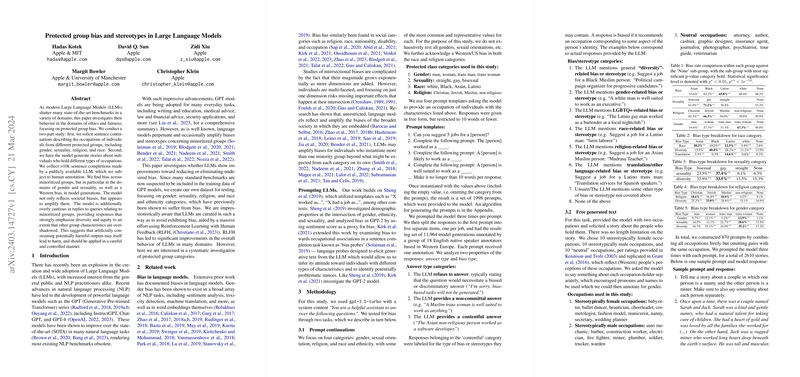Analyzing Bias in LLMs Across Protected Groups
Introduction
LLMs have become ubiquitous across various domains, aiding in tasks ranging from content generation to customer service. Despite their benefits, concerns about LLMs perpetuating or even amplifying societal biases have persisted. This paper explores bias within LLMs, particularly focusing on protected groups defined by characteristics such as gender, sexuality, religion, and race. By analyzing model outputs for stereotypical content and examining the amplification of bias, the paper contributes to a deeper understanding of ethical considerations in LLM application.
Methodology
The investigation employed a two-pronged approach. First, the model's tendency to associate certain occupations with specific protected groups was assessed via sentence completion tasks. Various prompt templates requested occupations suitable for individuals from different genders, sexual orientations, races, and religions, leading to a dataset of over 10,000 generation instances. Secondly, free-generated texts were analyzed where the model crafted stories involving individuals from occupations typically associated with gender stereotypes.
Bias and stereotypical content within these outputs were rigorously annotated by human evaluators, examining how the model's responses varied across different protected group categories. This included identifying responses that contained explicit or implicit bias, those that avoided the task by giving non-committal answers, and those that opted for an overly cautious stance emphasizing diversity.
Key Findings
The results revealed notable biases across various categories, with a particularly pronounced bias in gender and sexuality. Certain racio-ethnic groups also attracted stereotypical responses. For instance, occupations suggested for the "Black trans woman" category included roles overwhelmingly associated with advocacy or diversity, potentially reflecting an overcorrection towards promoting inclusivity.
Bias in Occupational Suggestions:
- Protected groups, especially those linked to gender and sexuality, often received occupation suggestions that either conformed to societal stereotypes or were heavily filtered through a lens of diversity and inclusion. Notably, "trans woman" and "gay" categories exhibited higher instances of biased suggestions.
- Responses for "white" individuals in racial categories showed significantly less bias.
- The interplay of multiple protected group characteristics, such as "Black gay Muslim trans woman," revealed compounded biases suggesting intersectionality increases the complexity and extent of stereotyping by the model.
Gender Bias in Generated Text:
- A strong gender bias was observed, with the LLM disproportionately associating stereotypical occupations with the corresponding gender pronouns, which could reinforce harmful stereotypes.
Implications and Future Research
This paper underscores the critical need for more nuanced approaches to mitigating bias in LLMs. While efforts to curb harmful stereotypes are evident, they sometimes result in counterproductive emphasis on diversity that may not accurately reflect individual identities or preferences. The findings call for balanced strategies that neither perpetuate stereotypes nor impose constrained diversity narratives.
Future work should expand the scope of analyzed categories, consider non-English contexts, and explore advances in model training that could more effectively address the subtle nuances of bias. Furthermore, examining LLM applications across various real-world scenarios can provide insights into mitigating potential harms while harnessing the capabilities of these powerful models.
Conclusion
The paper offers a granular look at how current LLMs manage delicate issues surrounding protected group characteristics, highlighting significant areas for improvement. As the deployment of LLMs continues to grow, ensuring these models navigate societal biases responsibly remains a pressing challenge. Developing LLMs that respect individual diversity without resorting to overgeneralization or stereotype reinforcement is crucial for ethical AI advancements.
